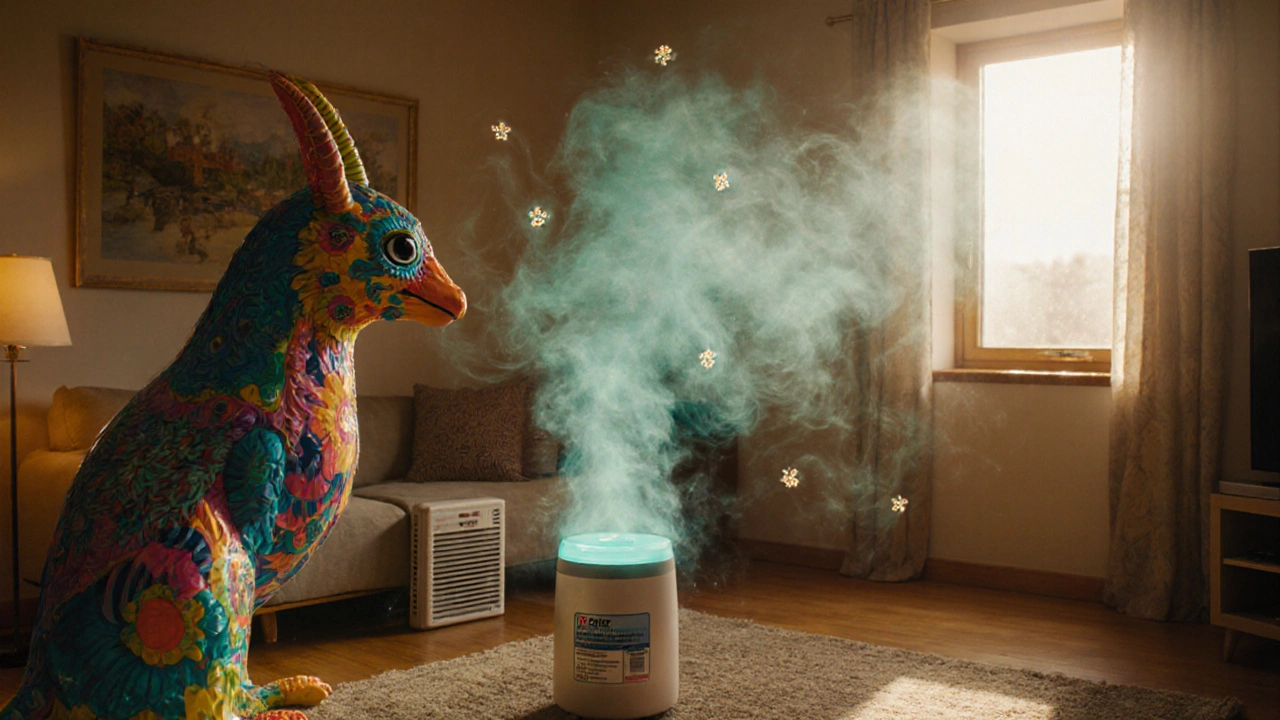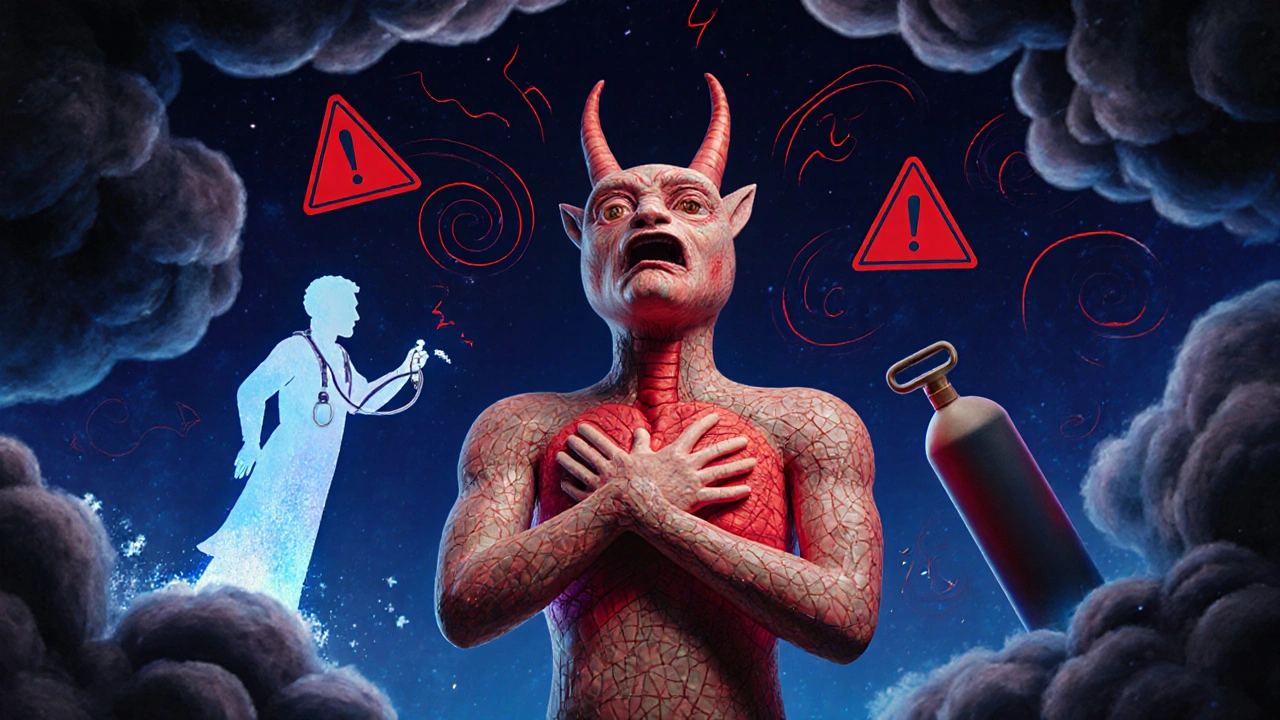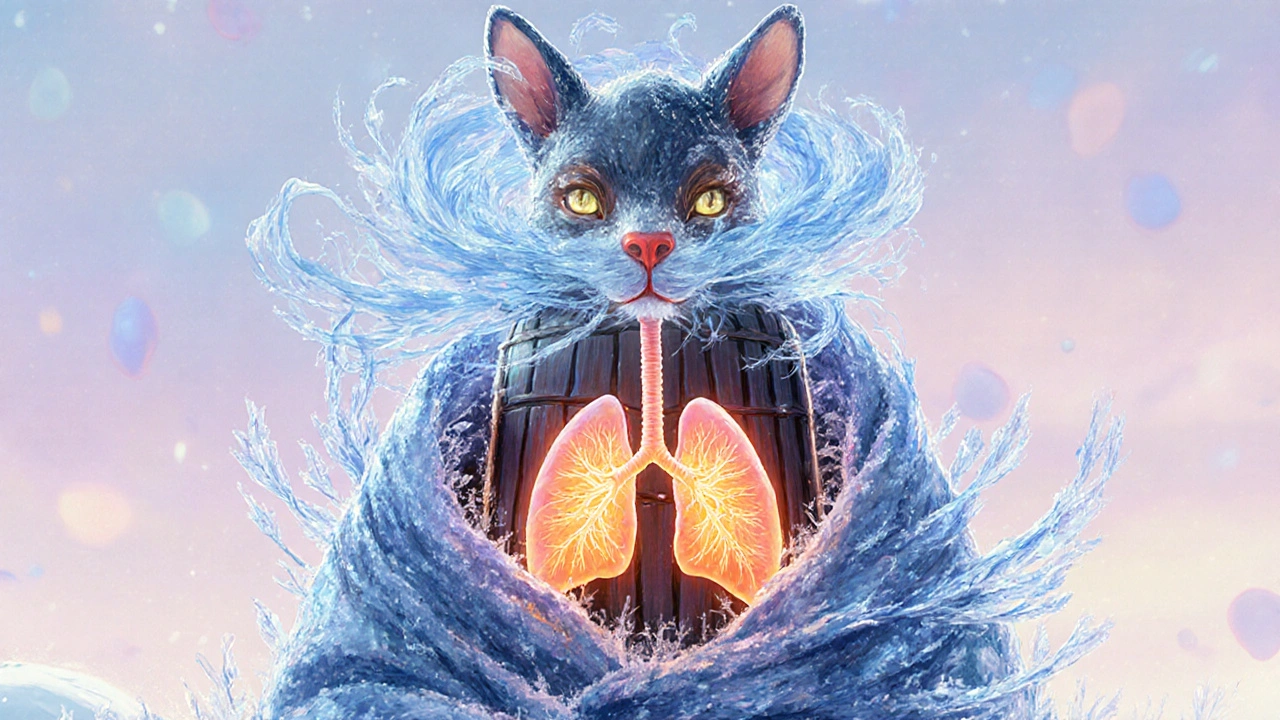Emphysema Winter Safety Calculator
Winter Lung Safety Assessment
Input your conditions to get personalized risk assessment and protection recommendations
Your Personalized Recommendations
When winter rolls in, the chill can feel like a heavy blanket over your chest, especially if you live with Emphysema, a chronic lung condition that destroys the tiny air‑sacs (alveoli) and makes breathing a constant effort. If you or a loved one live with Emphysema, winter can feel like a breath‑stealer.
What Is Emphysema?
Emphysema is a form of COPD (Chronic Obstructive Pulmonary Disease) marked by irreversible damage to the lung’s elastic fibers. The walls of the alveoli break down, reducing surface area for oxygen exchange. Typical signs include shortness of breath, a persistent cough, and a “barrel‑shaped” chest. Because the disease narrows the airway passages, any extra strain-like cold, dry air-can tip the balance toward an exacerbation.
How Cold Weather Affects Your Lungs
Cold air is denser than warm air, so each breath carries more oxygen molecules but also forces the lungs to work harder to warm and humidify it. For healthy people, the airway lining releases moisture to protect the bronchi, but in emphysema the lining is already compromised. The result? Irritation, bronchospasm, and a higher chance of mucus buildup.
Winter‑Specific Triggers You Can’t Ignore
- Dry Air: Low humidity dries the airway lining, making it easier for irritants to stick.
- Airborne Irritants: Indoor heating can stir up dust, pet dander, and mold spores.
- Respiratory Infections: Flu and colds spread more easily in closed environments, and they can rapidly worsen COPD symptoms.
- Cold‑Induced Vasoconstriction: Blood vessels in the lungs narrow, reducing oxygen delivery.
Protect Your Lungs Indoors
Most of your time during the cold months is spent inside. Turning your home into a lung‑friendly zone pays off.
- Use a Humidifier set to 30‑40% humidity. It adds moisture without making the air soggy, which can encourage mold.
- Keep indoor temperature moderate (68‑72°F). Over‑heating dries the air even more.
- Change HVAC filters every 1‑2 months to trap dust and pollen.
- Ventilate briefly each day by opening a window for 5‑10 minutes; fresh air lowers indoor pollutant concentration.
- Stay up‑to‑date on Vaccination (flu, COVID‑19, pneumonia) to reduce infection risk.

Safe Outdoor Strategies
Skipping the outdoors isn’t necessary, but you should take a few precautions.
- Layer clothing and wear a scarf or mask over your nose and mouth to warm the air before it hits your lungs.
- Plan activities for midday when temperatures are highest.
- Avoid high‑intensity exertion on very cold days; opt for a brisk walk rather than a jog.
- Check the air‑quality index; high particulate matter can compound irritation.
Medication & Treatment Tweaks for Winter
Winter may require adjustments to your regular regimen.
- Bronchodilators (short‑acting relievers) should be kept handy in case of sudden breathlessness.
- Long‑acting inhalers may need a higher dose-talk to your doctor before changing anything.
- If you use Oxygen Therapy, ensure your equipment works properly at low temperatures; cold can affect regulator performance.
- Consider a short course of oral steroids if you’ve had recent exacerbations; this can reduce airway inflammation quickly.
Lifestyle Tips That Make a Difference
Sometimes the smallest habits have the biggest impact.
- Quit Smoking if you haven’t yet-cold air makes smoke irritation worse.
- Stay hydrated; water helps keep mucus thin.
- Practice deep‑breathing exercises (e.g., pursed‑lip breathing) to improve ventilation.
- Engage in Pulmonary Rehabilitation programs to strengthen respiratory muscles.

When to Call Your Healthcare Provider
Know the red‑flag symptoms that signal an urgent need for medical attention:
- Sudden increase in shortness of breath that doesn’t improve with your rescue inhaler.
- Fever above 100.4°F combined with a worsening cough.
- Chest pain or tightness.
- Rapid heartbeat (over 100 bpm) at rest.
Early intervention can prevent a full‑blown exacerbation and a hospital stay.
Quick‑Reference Comparison Table
| Setting | Action | Why It Helps |
|---|---|---|
| Indoor | Use humidifier (30‑40% RH) | Adds moisture, reduces airway drying |
| Indoor | Change HVAC filter regularly | Traps dust and allergens that trigger cough |
| Outdoor | Wear a scarf or mask | Warms and humidifies inhaled air |
| Outdoor | Avoid high‑intensity activity in extreme cold | Prevents bronchospasm from sudden temperature shift |
| Both | Stay up‑to‑date on vaccinations | Reduces risk of infection‑driven flare‑ups |
Frequently Asked Questions
Why does cold air make breathing harder for people with emphysema?
Cold air is dry and dense, which irritates already damaged airways, causes bronchoconstriction, and forces the lungs to work harder to warm and humidify each breath.
Should I use a humidifier year‑round?
If your home stays dry (below 30% RH) most of the year, a humidifier helps continuously. In winter, it’s especially beneficial because heating systems dry the air.
Can flu shots prevent an emphysema flare‑up?
Yes. Influenza often triggers severe COPD exacerbations. Vaccination reduces the chance of catching the flu, thereby lowering the risk of a flare‑up.
Is it safe to exercise outdoors in sub‑40°F temperatures?
Mild to moderate activity is fine if you cover your mouth and nose with a scarf or mask to warm the air. Avoid high‑intensity workouts when it’s below freezing, as that can provoke bronchospasm.
What are the warning signs that I need emergency care?
Rapidly worsening shortness of breath, inability to speak full sentences, chest pain, high fever, or a sudden drop in oxygen saturation below 88% require immediate medical attention.

ashanti barrett
October 19, 2025 AT 22:13I keep a small humidifier on in the bedroom because the dry heating air hits my lungs like sandpaper. The extra moisture eases the irritation that cold, dry breaths cause in emphysema patients. I also layer up with a breathable scarf that warms the air before it reaches my throat. Staying hydrated and sipping warm tea throughout the day further prevents mucus from thickening.
Leo Chan
October 22, 2025 AT 05:46Great tip! Adding a breathable mask is a simple hack that lets you stay active without shocking the airways. I always time my walks for the warmest part of the day and keep a pocket inhaler handy. Consistency with these habits keeps my breathing steadier all winter.
jagdish soni
October 24, 2025 AT 13:20Winter is not merely a season but a metaphysical trial for the fragile alveolar architecture. The frigid air dense and unforgiving demands a renegotiation of the internal thermodynamic equilibrium. One must therefore approach respiration with the reverence of a scholar dissecting ancient texts. A scarf draped over the nose functions as a humble veil that tempers the hostility of the atmosphere. Humidifiers act as silent alchemists transmuting arid molecules into soothing vapors. Neglecting this subtle art leads to bronchial constriction that resembles the tightening of a tyrant's grip. Vaccinations, though mundane, are the societal contracts that shield us from microbial siege. Oxygen regulators, when chilled, betray their purpose and must be insulated like precious relics. Hydration, the most basic of elixirs, maintains the mucosal linings in a pliable state. Physical activity, paced wisely, stimulates the diaphragm without inciting spasms. Avoidance of high‑intensity exertion during sub‑zero hours prevents the cascade of inflammatory mediators. Indoor air filters, changed regularly, act as guardians against particulate invaders. Ventilation, brief yet deliberate, introduces fresh ether that dispels stagnant pollutants. When symptoms accelerate, the rescue inhaler becomes the philosopher's stone of immediate relief. Thus the winter regimen is a symphony of modest interventions that together preserve the breath of existence.
Latasha Becker
October 26, 2025 AT 20:53While humidifiers are widely recommended, clinicians note that excessive relative humidity can foster mold spore proliferation which paradoxically aggravates COPD pathology. The optimal humidity range is narrowly defined and should be monitored with calibrated hygrometers to avoid iatrogenic complications.
parth gajjar
October 29, 2025 AT 04:26The cold itself is a cruel adversary that gnaws at the very essence of pulmonary resilience. Every exhalation feels like a battle against an unseen frost that congeals within the bronchi. One must armor the airway with scarves and humidified breaths lest the chest succumb to an icy tyranny.
Maridel Frey
October 31, 2025 AT 12:00For individuals managing emphysema, establishing a structured routine that incorporates daily humidifier checks, regular filter replacements, and scheduled vaccination appointments is essential. Pair these measures with education on proper inhaler technique and you create a comprehensive defense against winter exacerbations. If you need assistance tailoring this plan, feel free to reach out for personalized guidance.
Madhav Dasari
November 2, 2025 AT 19:33Listen up friends the winter battle isn’t a drama you can ignore it’s a marathon and you’ve got to gear up with a scarf and a trusty inhaler like a sidekick. Keep that humidifier humming and drink tea like it’s fuel for your lungs and you’ll ride through the cold like a champion. And remember every small habit adds up so don’t skip the daily filter swap it’s the quiet hero of the season.
Ben Bathgate
November 5, 2025 AT 03:06Honestly most of these tips are just common sense you could find on any health blog the only thing missing is a realistic discussion of cost barriers for low‑income patients.
Ankitpgujjar Poswal
November 7, 2025 AT 10:40Stop making excuses and put the plan into action today-set the humidifier to 35 % humidity, replace the HVAC filter now, and schedule that flu shot before the next snowstorm. Your lungs will thank you and you’ll avoid another preventable flare‑up.